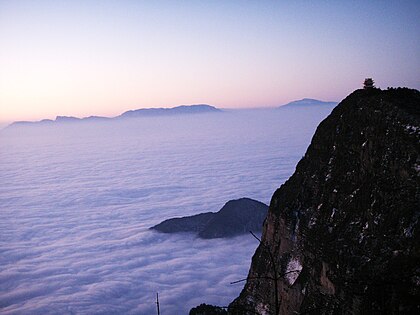Mount Emei




| Mount Emei | |||||||||||||||||||||||||||||
|---|---|---|---|---|---|---|---|---|---|---|---|---|---|---|---|---|---|---|---|---|---|---|---|---|---|---|---|---|---|
 "Mount Emei" in Chinese characters | |||||||||||||||||||||||||||||
| Chinese | 峨眉山[2] | ||||||||||||||||||||||||||||
| |||||||||||||||||||||||||||||
| Part of a series on |
| Chinese martial arts (Wushu) |
|---|
 |
| Historical locations |
| Legendary figures |
| Modern celebrities
|
| Related
|
|
Mount Emei ([ɤ̌.měɪ]; Chinese: 峨眉山[2]; pinyin: Éméi shān), alternatively Mount Omei, is a 3,099-metre-tall (10,167 ft) mountain in Sichuan Province, China, and is the highest of the Four Sacred Buddhist Mountains of China.[3] Mount Emei sits at the western rim of the Sichuan Basin. The mountains west of it are known as Daxiangling.[4] A large surrounding area of countryside is geologically known as the Permian Emeishan Large Igneous Province, a large igneous province generated by the Emeishan Traps volcanic eruptions during the Permian Period.
Administratively, Mount Emei is located near the county-level city of the same name (Emeishan City), which is in turn part of the prefecture-level city of Leshan. It was made a UNESCO World Heritage Site in 1996.[5]
Name
Emei means "moth-browed".[6]
Relevance to Buddhism
Chinese people offer burning sandalwood near the mountain to send their "prayers to heaven".[7]
As a sacred mountain
Mount Emei is one of the Four Sacred Buddhist Mountains of China, and is traditionally regarded as the bodhimaṇḍa, or place of enlightenment, of the Bodhisattva Samantabhadra. Samantabhadra is known in Mandarin as Pǔxián Púsà (普賢菩薩).
Sources of the 16th and 17th centuries allude to the practice of martial arts in the monasteries of Mount Emei,[8] which made the earliest extant reference to the Shaolin Monastery as the place of origin of Chinese martial arts.[9]
Chinese Buddhist pilgrims regularly travel to the mountain.[7]
Buddhist architecture on Emei
This is the location of the first Buddhist temple built in China in the 1st century CE.[5] The site has seventy-six Buddhist monasteries of the Ming and Qing dynasties, most of them located near the mountain top. The monasteries demonstrate a flexible architectural style that adapts to the landscape. Some, such as the halls of Baoguosi, are built on terraces of varying levels, while others, including the structures of Leiyinsi, are on raised stilts. Here the fixed plans of Buddhist monasteries of earlier periods were modified or ignored in order to make full use of the natural scenery. The buildings of Qingyinge are laid out in an irregular plot on the narrow piece of land between the Black Dragon River and the White Dragon River. The site is large and the winding footpath is 50 km (31 mi) long, taking several days to walk.[10]
Cable cars ease the ascent to the two temples at Jinding (3,077 m), an hour's hike from the mountain's peak.[3][11]
Climate
The summit of Mount Emei has an alpine subarctic climate (Köppen Dwc), with long, cold (but not severely so) winters, and short, cool summers. The monthly 24-hour average temperature ranges from −5.7 °C (21.7 °F) in January to 11.6 °C (52.9 °F) in July, and the annual mean is 3.07 °C (37.5 °F). Precipitation is common year-round (occurring on more than 250 days), but due to the influence of the monsoon, rainfall is especially heavy in summer, and more than 70% of the annual total occurs from June to September.
| Climate data for Mount Emei (elevation 3,070 m (10,070 ft), 1991–2020 normals, extremes 1971–2000) | |||||||||||||
|---|---|---|---|---|---|---|---|---|---|---|---|---|---|
| Month | Jan | Feb | Mar | Apr | May | Jun | Jul | Aug | Sep | Oct | Nov | Dec | Year |
| Record high °C (°F) | 16.7 (62.1) | 18.5 (65.3) | 20.5 (68.9) | 22.7 (72.9) | 21.7 (71.1) | 22.5 (72.5) | 22.1 (71.8) | 21.5 (70.7) | 19.8 (67.6) | 19.3 (66.7) | 19.5 (67.1) | 16.3 (61.3) | 22.7 (72.9) |
| Mean daily maximum °C (°F) | −0.2 (31.6) | 1.8 (35.2) | 4.6 (40.3) | 8.4 (47.1) | 11.1 (52.0) | 13.5 (56.3) | 15.7 (60.3) | 15.1 (59.2) | 12.2 (54.0) | 7.5 (45.5) | 5.0 (41.0) | 1.1 (34.0) | 8.0 (46.4) |
| Daily mean °C (°F) | −5.5 (22.1) | −3.6 (25.5) | −0.6 (30.9) | 3.7 (38.7) | 6.9 (44.4) | 9.9 (49.8) | 12.1 (53.8) | 11.5 (52.7) | 8.6 (47.5) | 4.0 (39.2) | 0.5 (32.9) | −3.7 (25.3) | 3.7 (38.6) |
| Mean daily minimum °C (°F) | −8.8 (16.2) | −6.9 (19.6) | −3.7 (25.3) | 0.7 (33.3) | 4.1 (39.4) | 7.4 (45.3) | 9.8 (49.6) | 9.3 (48.7) | 6.4 (43.5) | 1.9 (35.4) | −2.3 (27.9) | −6.8 (19.8) | 0.9 (33.7) |
| Record low °C (°F) | −19.2 (−2.6) | −19.1 (−2.4) | −17.2 (1.0) | −9.8 (14.4) | −7.4 (18.7) | −0.2 (31.6) | 2.1 (35.8) | 2.8 (37.0) | −3.5 (25.7) | −11.1 (12.0) | −14.7 (5.5) | −19.7 (−3.5) | −19.7 (−3.5) |
| Average precipitation mm (inches) | 13.3 (0.52) | 21.5 (0.85) | 57.7 (2.27) | 118.4 (4.66) | 169.2 (6.66) | 214.8 (8.46) | 348.2 (13.71) | 385.2 (15.17) | 192.7 (7.59) | 90.7 (3.57) | 35.5 (1.40) | 14.0 (0.55) | 1,661.2 (65.41) |
| Average precipitation days (≥ 0.1 mm) | 14.9 | 15.9 | 20.7 | 21.1 | 21.7 | 23.2 | 22.2 | 21.9 | 22.6 | 24.6 | 16.9 | 13.9 | 239.6 |
| Average snowy days | 15.3 | 13.1 | 14.0 | 7.6 | 2.1 | 0.1 | 0.0 | 0.1 | 0.3 | 4.4 | 8.2 | 10.8 | 76 |
| Average relative humidity (%) | 79 | 80 | 85 | 86 | 85 | 87 | 89 | 90 | 91 | 93 | 86 | 80 | 86 |
| Mean monthly sunshine hours | 147.2 | 138.2 | 142.8 | 132.5 | 113.2 | 91.1 | 110.9 | 113.4 | 89.0 | 77.4 | 131.0 | 143.3 | 1,430 |
| Percent possible sunshine | 45 | 44 | 38 | 34 | 27 | 22 | 26 | 28 | 24 | 22 | 41 | 45 | 33 |
| Source 1: China Meteorological Administration[12][13] | |||||||||||||
| Source 2: Weather China[14] | |||||||||||||
Indigenous animals
There are nearly 400 total species of animals, invertebrates and plants native to the mountain. There are at least six snake species native to the region, including the Chinese slug snake, Mandarin ratsnake, mountain water snake, Peters' odd-scaled snake, plus some potently venomous species, such as the Chinese green tree viper, the brown spotted pitviper and the Taiwan mountain pitviper.
Visitors to Mount Emei will likely see dozens of Tibetan macaques, which can often be viewed taking food from tourists. A famously well-fed, one-armed, elderly female macaque named Xing Xing has millions of views on YouTube, seemingly showing the macaques’ complete disdain for the hordes of tourists who are often offering them food directly in their faces. It seems that only one elderly woman who lives on the mountain, and her son, are able to be close to Xing Xing, to feed and pet her. Xing Xing appears to consider the woman her best friend, while shunning the offers of food from strangers. If tourists persist in holding food in the monkeys’ faces, they will aggressively grab at the person’s clothing and stare at them, and not let go. If the person continues to irritate the macaque, they are very easily angered and prone to bite. Still, local merchants sell nuts and other foods for the tourists to attempt to feed the monkeys.
Other local animals include lizards, such as the Indian forest skink and the lacerta Takydromus intermedius, the frogs Rana adenopleura and Vibrissaphora liui, and a giant, half-metre long earthworm species, Pheretima praepinguis.
Flora
Mount Emei is known for its high level of endemism and approximately 200 plant species in various plant families have been described from this mountain.
A rare species of Fir tree is endemic to this mountain it is Abies Fabri.


Gallery
-
 Wanfoding
Wanfoding -
 A temple at the Golden Summit
A temple at the Golden Summit -
 Massive statue of Samantabhadra at the summit of Mount Emei
Massive statue of Samantabhadra at the summit of Mount Emei -
 Baoguo Temple, a Buddhist temple
Baoguo Temple, a Buddhist temple - Buddhist temple at Mount Emei
-
 Wooden bridgewalk over the Crystal Stream, western slopes
Wooden bridgewalk over the Crystal Stream, western slopes -
 Macaque indigenous to the region
Macaque indigenous to the region -
 Sunrise over Mount Emei
Sunrise over Mount Emei -
 Sunrise over a sea of clouds at Mount Emei
Sunrise over a sea of clouds at Mount Emei - Guangfu pavilion, with summit visible in background
-
 Elephant statues on the steps leading to the statue of Samantabhadra
Elephant statues on the steps leading to the statue of Samantabhadra -
 Monkeys of Mount Emei
Monkeys of Mount Emei -
 Mount Emei and Exiu Lake
Mount Emei and Exiu Lake -
 Mount Emei and Exiu Lake
Mount Emei and Exiu Lake
See also
- Baoguo Temple
- Fuhu Temple
- Jinding, main peak of Mount Emei
- Shengji Bronze Bell
- Wannian Temple
- Xixiang Chi, also known as Tianhua Chanyuan
- Zuo Ci
- Emei School, fictional martial arts school
References
- ^ "Topographic map of Emei". opentopomap.org. Retrieved 2023-05-11.
- ^ a b In the name "Emei", the character méi 眉 is sometimes written 嵋; the character "É" 峨 is occasionally written 峩.
- ^ a b Hayes, Holly (2009) Emei Shan, Sacred Destinations. Updated 24 July 2009.
- ^ E.g., 实用中国地图集 (Shiyong Zhongguo Dituji, "Practical Atlas of China"), 2008, ISBN 978-7-5031-4772-2; map of Sichuan on pp. 142–143
- ^ a b "Mount Emei Scenic Area, including Leshan Giant Buddha Scenic Area". UNESCO. Retrieved 2007-09-06.
- ^ Guangwei, He; Hualing, Tong; Wenzhen, Yang; Zhenguo, Chang; Zeru, Li; Ruicheng, Dong; Weijan, Gong, eds. (1999). Spectacular China. Translated by Wusun, Lin; Zhongping, Wu. Cologne: Könemann. p. 98. ISBN 9783829010771.
- ^ a b Cohen, David, ed. (1989). A Day in the Life of China. San Francisco: Collins. pp. 108, 150. ISBN 978-0-00-215321-8.
- ^ Zhāng Kǒngzhāo 張孔昭 (c. 1784). Boxing Classic: Essential Boxing Methods 拳經拳法備要 Quánjīng Quánfǎ Bèiyào (in Chinese).
- ^ Henning, Stanley E. (Fall 1999). "Academia Encounters the Chinese Martial Arts". China Review International. 6 (2): 319–332. doi:10.1353/cri.1999.0020. ISSN 1069-5834..
- ^ Dazhang, Sun (2002). Chinese Architecture -- The Qing Dynasty (English ed.). Yale University Press. pp. 328–329. ISBN 0-300-09559-7.
- ^ Gluckman, Ron (2002). Getting to the Top, Silk Road, December 2002. Hong Kong; Dragon Airlines.
- ^ 中国气象数据网 – WeatherBk Data (in Simplified Chinese). China Meteorological Administration. Retrieved 10 October 2023.
- ^ 中国气象数据网 (in Simplified Chinese). China Meteorological Administration. Retrieved 10 October 2023.
- ^ "峨眉山城市介绍". Weather China. 2023-04-20. Archived from the original on 2023-04-20.
External links

- Religion and the environment in China, 中国的宗教与环境 - chinadialogue article
- Mount Emei, including Leshan Giant Buddha, Scenic Area: official Unesco site

























